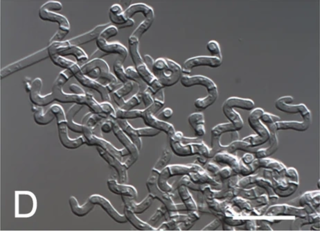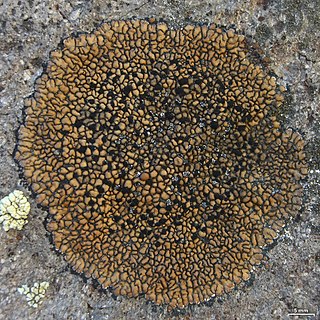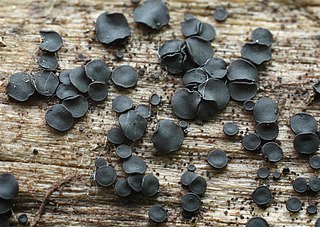
Diaporthales is an order of sac fungi.

The Botryosphaeriales are an order of sac fungi (Ascomycetes), placed under class Dothideomycetes. Some species are parasites, causing leaf spot, plant rot, die-back or cankers, but they can also be saprophytes or endophytes. They occur world-wide on many hosts. For example, in China, infections related to Botryosphaeriales have been recorded on numerous hosts such as grapes, Caragana arborescens,Cercis chinensis, Eucalyptus, Chinese hackberry, blueberry, forest trees, and various other woody hosts.

The Lecanoromycetidae are a subclass of fungi in the class Lecanoromycetes. This subclass contains seven orders:

The Pertusariales are an order of fungi in the class Lecanoromycetes. It contains the following families: Coccotremataceae, Icmadophilaceae, Megasporaceae, Microcaliciaceae, Ochrolechiaceae, Pertusariaceae, Varicellariaceae, and Variolariaceae. Many of these fungi form lichens.

Pycnothelia is a genus of lichen-forming fungi in the family Cladoniaceae. Pycnothelia was promoted to generic status by French naturalist Léon Jean Marie Dufour in 1821; it was originally circumscribed by Erik Acharius in 1799 as a section of the now-defunct genus Cenomyce.
Broomella is a genus of fungi in the family Sporocadaceae.
Parmularia is a genus of fungi in the family Parmulariaceae. The genus was circumscribed by Joseph-Henri Léveillé in 1846.

Xylobotryum is a genus of fungi in the Ascomycota phylum and in the order of Xylobotryales.
Aulographina is a genus of fungi. It was placed in the Asterinaceae family. then later placed in the Teratosphaeriaceae family.

Arachnomyces is a genus of cleistothecial ascomycete fungi described in 1902, of which the anamorph (asexual) stage is the genus Onychocola. Although morphologically similar to members of other families, the fungus now belongs to its own monotypic family Arachnomycetaceae, which is the only family in the monotypic order Arachnomycetales.

The Ophiostomataceae are a family of fungi in the Ascomycota, class Sordariomycetes. The family was circumscribed by J.A. Nannfeldt in 1932. Species in the family have a widespread distribution, and are typically found in temperate regions, as pathogens of both coniferous and deciduous trees.

George Edward Massee was an English mycologist, plant pathologist, and botanist.

Bulgaria is a genus of fungi in the family Phacidiaceae. The genus was circumscribed in 1822 by Elias Magnus Fries, with Bulgaria inquinans assigned as the type species.

Bertia is a genus of fungi within the Bertiaceae family, and Hypocreomycetidae subclass.

The Lecideales are an order of lichenized fungi in the class Lecanoromycetes. The order contains two families: the Lecideaceae, which contains 29 genera and about 260 species, and Lopadiaceae, which contains the single genus Lopadium of 10 species.

Cordieritidaceae is a family of fungi in the order Cyttariales. Species in this family are saprobes or lichenicolous.
Dilophospora is a genus of fungi belonging to the order Dothideomycetes, in the family Sporocadaceae.

Patellaria is a genus of fungi in the family Patellariaceae. The genus was circumscribed in 1822 by mycologist Elias Magnus Fries with Patellaria atrata assigned as the type species.
Oidiodendron is a genus of fungi in the family Myxotrichaceae. It has 26 species. The genus was circumscribed by Norwegian forester Håkon Robak in 1932, with Oidiodendron fuscum assigned as the type species. The species is now known as Oidiodendron tenuissimum.
Pucciniosira is a genus of rust fungi belonging to the family Pucciniosiraceae.














